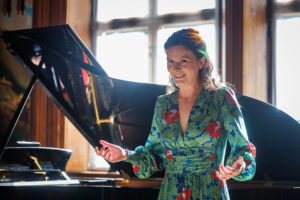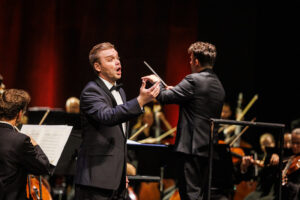One day during a recent stay in Oslo, I decided to return to my hotel by tram. After a while I got the impression that the tram turned the wrong way. No one reacted. However, the calmness of the passengers ceased to infect me, when the tram came to a halt between stops. The driver announced that he had forgotten to move the points, but would rectify his mistake immediately. The tram began to reverse, with the passengers still on board and still not commenting on the incident. It moved back to the junction and rolled in the right direction. A few streets down it had to return to the depot. Everyone got off without a word and continued on foot.
The situation made me think about a book by Thorbjørn Egner I read as a child. More specifically, about the fragment in which the three eponymous robbers of Cardamom are released from jail: “‘Why don’t you take a ride on the tram?’ ‘Yes, thank you,’ they replied (…). ‘It’ll be nice to take a ride now’. (…) The conductor rang the bell and the tram began to move”. This is a summary, as it were, of Kardemommeloven, or the law of Cardamon Town: you must not tease anyone, you must be nice and polite, apart from that everything is allowed. The Norwegians are held up as a model of civil society. Mutual respect, observance of legal norms and cooperation with state agencies are not seen as a sign of weakness in this country. Just as reticence in showing feelings is not a sign of boorishness, but stems from a reluctance to do unto another what is disagreeable to you. Norwegians value their peace and, therefore, do not disturb others.
How effective a strategy this is has been demonstrated by the last century of the country’s history. In 1905, after the dissolution of the personal union with Sweden, Norway began to rebuild its identity and patiently develop a velferdsstat – a welfare state. Today it boasts one of the highest levels of per capita income in the world and ranks second in the global Human Development Index. Citizens pay their high taxes conscientiously, benefiting in exchange from state-funded education, social welfare and health care. Norway is an extremely egalitarian country, where the principle of equality applies irrespective of gender, religion, social background and ability. Egalitarianism is also advocated by members of the royal family, led by King Harald V, who ascended the throne in 1991, inheriting from his ancestors the motto “Alt for Norge”: everything for Norway. The king’s 2016 speech contained some memorable words: that Norway is first and foremost about people; girls who love girls, boys who love boys, and boys and girls in love with each other who believe in God, in Everything or in Nothing. Kai Østensen – a Christian LGBT activist – summed up the speech with the words “I love the king. Amen”.
Liv Redpath at Oscarshall. Photo: Per Ole Hagen
The king is also loved by his wife, Queen Sonja: it is possible that their complicated love story has also contributed to his worldview. Sonja was a “commoner”, the daughter of a small businessman, a graduate of a tailoring programme at a vocational school, a boarding school in Lausanne and the University of Oslo, where she obtained her bachelor’s degree. For a long time the young couple kept their relationship a secret. Finally, Harald told his father that if he stood in the way of his happiness with Sonja, he would not marry anyone else. The argument proved irrefutable: the crown prince was the only male heir to the Norwegian throne. The wedding ceremony took place in 1968 at Oslo Cathedral. King Olaf V led his bride down the aisle to the sounds of Purcell’s Trumpet Tune And Air, and the newlyweds left the church to the accompaniment of Bach’s Prelude in E flat major BWV 552/1.
A lavish musical setting of the ceremony was a tradition in the Norwegian royal family, which is related to the ruling houses of Denmark, Sweden and United Kingdom. The future king studied at Oxford, but that period brought him primarily a love of water sports. His wife, on the other hand, an avid music lover and patron of young artists, turned out to be a true ambassador of music in Norway. An initiative that has become firmly established in the international music community is the Queen Sonja Competition, launched in 1988. This year – at the invitation of the organisers and the Ophelias Culture PR agency – I had the pleasure of watching the events of the final few days of the competition.
They began with a private concert at Oscarshall, a neo-Gothic maison de plaisance built on the Bygdøy peninsula above the Frognerkilen fjord. The palace, the decor of which is the work of Norwegian craftsmen and artists, was opened to the public as early as in 1881. Converted into a museum during the reign of the current royal couple, it proved an ideal venue for an intimate recital of songs and chamber works by Grieg, Debussy and Walton, featuring the soprano Liv Redpath and the pianist Sveinung Bjelland. The young American, who won the Lied Prize at the previous competition, is already making a career on both sides of the Atlantic. Deservedly so: her colourful, sensual voice and wise interpretations whetted everyone’s appetite for the auditions of this year’s finalists.
The auditions took place at the Norwegian National Opera, one of the first architectural wonders of the twenty-first century. The building blends perfectly into the urban fabric, also attracting tourists, who begin exploring it on the very shore of Oslofjorden, before climbing to the top of the building on the slanted roof, from which they can admire the panorama of the capital to their hearts’ content.
QSSC final concert: Vladyslav Tlushch, baritone, Ukraine. Photo: Per Ole Hagen
The Norwegian government launched a competition for the Opera House building in 1999. The submissions were evaluated by a professional jury and more than seventy thousand residents of Oslo. The winner was a design by the international Snøhetta group. Construction work began in 2003 and was completed four years later – not only ahead of schedule, but also at a much lower cost than planned, despite the fact that the finest materials were used in the construction.
White granite and marble create an impression of a glacier flowing into the waters of the bay. Above the stage rises an aluminium tower covered with a pattern reminiscent of Norwegian weaving techniques. The entrance is through a gap in the façade – directly into the foyer, with panels of glass supported by steel columns and a wooden “core” that surrounds the stage and the auditorium. The oak slats used for the interior were treated with ammonia, giving them the appearance of seasoned wood. The plafond chandelier casts light diffused through six thousand hand-cut crystals. Several hundred computer models were tested in the design of the acoustics, a process resulting in a perfect two-second reverberation.
At the Opera House we had a meeting with the executive director of the competition, Lars Hallvard Flaeten, who made us aware of the surprising conflict between the Norwegian mentality and the very idea of musical competition. What Norwegians regarded as a mad idea came from the conductor Mariss Jansons, who arrived in Oslo in 1979. If he had not elevated the local Philharmonic Orchestra to a European level during his tenure, even the crown princess would not have been persuaded. However, her competition was to be governed by different rules: uniting rather than dividing, opening a window to the world for Norwegian artists, and opening the eyes of the world to the Norwegian music scene. It started as a piano competition. In 1995 it changed its profile and has been held as the Queen Sonja Singing Competition every two years ever since. Today anyone can apply for entry. The participants’ contest is accompanied by master classes and stage interpretation workshops. The main goal, Flaeten argues, is not to win, but to gain the experience needed in the increasingly versatile world of modern opera.
This year the Norwegian egalitarianism came up against war. The organisers decided not to admit participants from Russia and Belarus – a difficult decision because of the singers’ protests and because of concerns about the quality of the competition, in which representatives of the two nations had ranked among the finalists and winners for years. Yet works by Russian composers were allowed in the repertoire: on the last day Tchaikovsky’s music was heard as many as three times. Doubts arise as to whether the jury acted in accordance with the Kardemommeloven, since in the finals it is the jury that selects the participants’ repertoire, and among those admitted to the final was a Ukrainian national.
QSSC final concert: Jasmin White, contralto, USA. Photo: Per Ole Hagen
However, the atmosphere of the concert – featuring the local orchestra under the baton of James Gaffigan, and Lise Davidsen, who as a host was as brilliant as she had been in Wagner’s roles on the world’s best stages – was joyful and unpretentious. The contest was close, although the podium – apart from the winner, Jasmin White from the United States, a singer endowed with a beautiful contralto voice and an endearing personality – lacked individuality to match the challenges of twenty-first-century opera. We will certainly hear more about White in the future: their final performance was not without some lapses, nevertheless the way White concealed them with purely musical means (especially in Juno’s aria from Handel’s Semele) testifies to the singer’s uncommon intelligence and stage presence. The second prize winner, Armenian baritone Aksel Daveyan, has a lovely, well-controlled voice of the kind that is quickly forgotten – perhaps because his interpretations did not give the impression that they were supported by any in-depth reflection. I found the third prize winner, German countertenor Nils Wanderer, more memorable, mainly because of his poignant performance of “Stille amare” from Handel’s Tolomeo – though I suspect the singer’s voice is not agile enough to win the listeners’ hearts with his overall take on roles in the Baroque repertoire. I wish the Ukrainian baritone Vladyslav Tlushch had made it to the podium. He was rather pale in the aria from Bellini’s I Puritani, but impressed me greatly with his perfect sense of the French style in the chanson bacchique from Thomas’ Hamlet . However, I have no right to question the jury’s verdict on the basis of one stage of the competition, especially as singing is no longer the only indicator of an artist’s potential on contemporary stages.
Let us assume, therefore, that in Oslo all were primi inter pares. I guess we need such a conclusion, not only in the ruthless world of the operatic business.
Translated by: Anna Kijak
Link to the source text:
https://www.tygodnikpowszechny.pl/kult-rownosci-po-norwesku-184599



